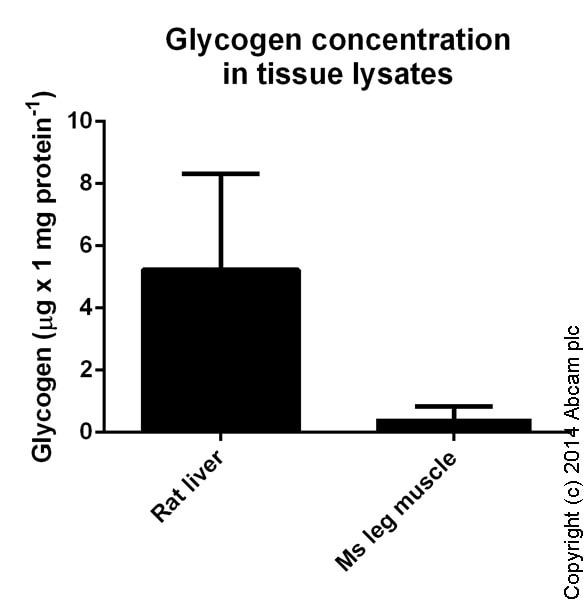Glycogen Assay Kit II (Colorimetric) (ab169558)
Key features and details
- Assay type: Quantitative
- Detection method: Colorimetric
- Platform: Microplate reader
- Assay time: 1 hr
- Sample type: Adherent cells, Suspension cells, Tissue
- Sensitivity: 4 µg/ml
Overview
-
Product name
Glycogen Assay Kit II (Colorimetric)
See all Glycogen kits -
Detection method
Colorimetric -
Sample type
Tissue, Adherent cells, Suspension cells -
Assay type
Quantitative -
Sensitivity
> 4 µg/ml -
Range
4 µg/ml - 40 µg/ml -
Assay time
1h 00m -
Species reactivity
Reacts with: Mammals, Other species -
Product overview
Glycogen Assay Kit II (Colorimetric) ab169558 provides a simple, fast and robust way to measure glycogen levels in biological samples.
This glycogen assay is suitable for measuring glycogen levels in samples that contain reducing substances, which may interfere with oxidase-based assays (such as our most popular glycogen assay kit ab65620).
In this glycogen assay protocol, glycogen is hydrolyzed into glucose, which is oxidized to form an intermediate that reduces a colorless probe to a colored product with strong absorbance at 450 nm. This high-throughput suitable assay kit can detect 4 - 40 µg/ml of glycogen in samples.
Glycogen assay protocol summary:
- add samples and standards to wells
- add hydrolysis enzyme and incubate for 30 min at room temp
- add reaction mix and incubate for 30 min at room temp
- analyze with microplate reader -
Notes
Review our Metabolism Assay Guide to learn about assays for metabolites, metabolic enzymes, mitochondrial function, and oxidative stress, and also about how to assay metabolic function in live cells using your plate reader.
Abcam has not and does not intend to apply for the REACH Authorisation of customers’ uses of products that contain European Authorisation list (Annex XIV) substances.
It is the responsibility of our customers to check the necessity of application of REACH Authorisation, and any other relevant authorisations, for their intended uses. -
Platform
Microplate reader
Properties
-
Storage instructions
Store at -20°C. Please refer to protocols. -
Components Identifier 100 tests Development Enzyme Mix (lyophilized) Green 1 vial Glycogen Development Buffer 1 x 25ml Glycogen Hydrolysis Buffer 1 x 25ml Glycogen Standard (2.0 mg/ml) Yellow 1 x 100µl Hydrolysis Enzyme Mix (lyophilized) Blue 1 vial Probe 1 vial -
Research areas
-
Relevance
Glycogen is the primary short term energy storage molecule in animals. It is synthesized primarily in the liver and muscle. Glycogen is a highly branched polymer of glucose molecules, connected with an alpha-1,4 linkage, branching via an alpha-1,6 linkage. Abnormal ability to utilize glycogen is found in diabetes and in several genetic glycogen storage diseases.
Images
-
Glycogen measured in cell lysates showing quantity (µg) per 1 mln cells.
Samples with the concentration of 1e7 cells/mL (HeLa) and 6.6e6 cells/mL (HCT116) were used. Samples were diluted 2-6 fold.
-
Glycogen measured in tissue lysates showing quantity (µg) per mg of extracted protein.
Protein concentration for samples varied from 25 mg/mL to 50 mg/mL. Samples were diluted 2-54 fold.
-
Standard curve: mean of duplicates (+/- SD) with background reads subtracted
-
 Glycogen metabolism Aw WC, Towarnicki SG, Melvin RG, et al., PLoS Genet. 2018;14(11):e1007735, Fig 14a, doi:10.1371/journal.pgen.1007735. Reproduced under the creative commons license. http://creativecommons.org/licenses/by/4.0/
Glycogen metabolism Aw WC, Towarnicki SG, Melvin RG, et al., PLoS Genet. 2018;14(11):e1007735, Fig 14a, doi:10.1371/journal.pgen.1007735. Reproduced under the creative commons license. http://creativecommons.org/licenses/by/4.0/Glycogen level was highest in Alstonville larvae (n = 10 biological rep/mitotype).











